Orthopedic silicone insoles
![]()
- Knee recurrence
- Surgical cases
- Correction of a limb
- Pain in the knee joint during flexion and extension
- Why do toe joints hurt after giving birth to a child?
- Treatment of flat feet
- Advice and recommendations from an orthopedic surgeon at the Perseus Orthopedic Center. Tel. 8 (495) 469-99-05
- hallux valgus
- Osteoarthritis of the knee joint
- How to reduce swelling in the knee joint?
- Cysts in the knee joint have the following causes
- The mobility of the joint is independent of
- Congenital deformity of the knee
- Clinic automation: fast and inexpensive!
- Clinic automation: fast and cheap!
- Diagnosis
- Silicone protectors for the first toe joint
- Application of fir oil for joints
- Treatment of the recurrent knee - all doctors 17
- Treatment of knee recurrence
- Advice before visiting an orthopedist
- Moscow orthopedists – opinions
Knee recurrence
Knee recurrence (genu recurvatume) – seen from the side, the knees are bent backwards. Often children have a very mobile body, which is not a problem but can lead to a knee recurrence at a later date.
The main cause of recurrence is damage to the growth plate at a young age. There are some unsolved cases.
A recurrence can cause the knee joint to be overloaded from the front, causing knee pain. Externally, the back curvature looks the same in all people, but the location of the curvature can vary from person to person. It may also be caused by weak ligament tissue (ligament laxity) rather than bony deformity, so care must be taken in treatment.
It is therefore very important not to make the mistake of opting for treatment without doing thorough research first, as this can have a negative impact on the knee later.
Safe recurrence treatment in the Scientific Orthopedics Center of Dr. Lee Donghong
Lee Dongghoon Scientific Orthopedic Center offers safe recurrence treatment with a minimal incision internal fixator and minimal surgical intervention.
Surgical cases
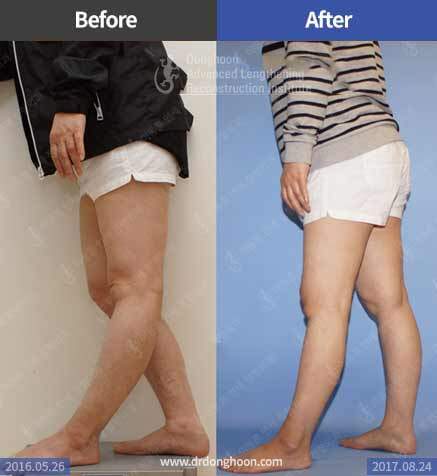
Surgical correction of the recurrence
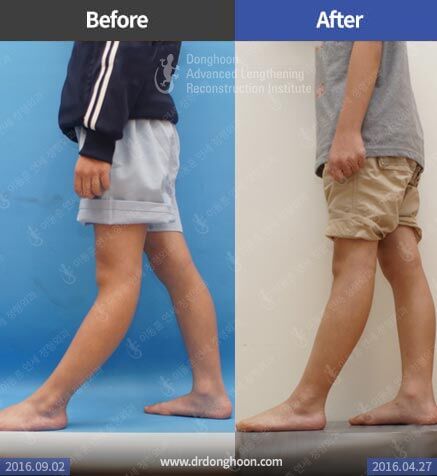
Surgical correction of a recurrence
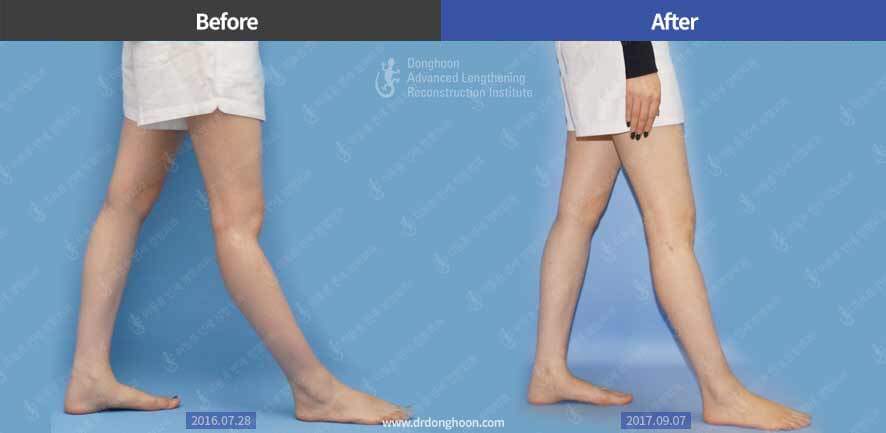
Surgical correction of a recurrence
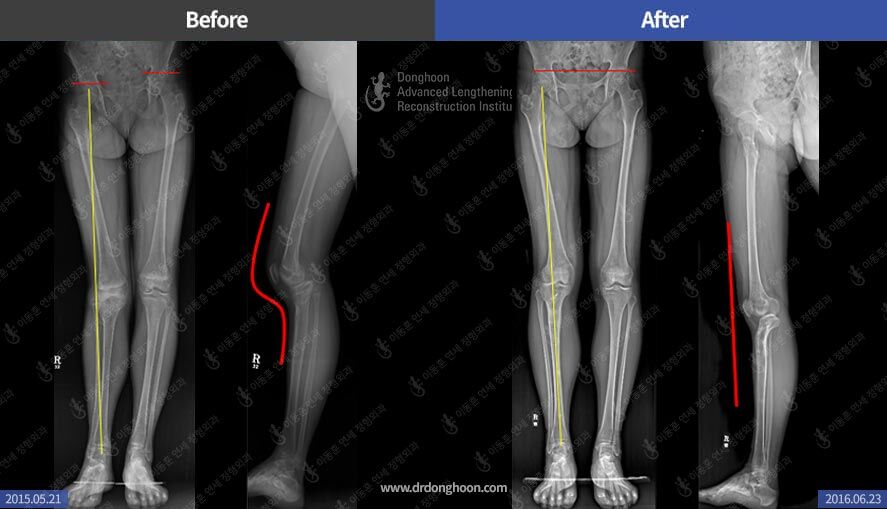
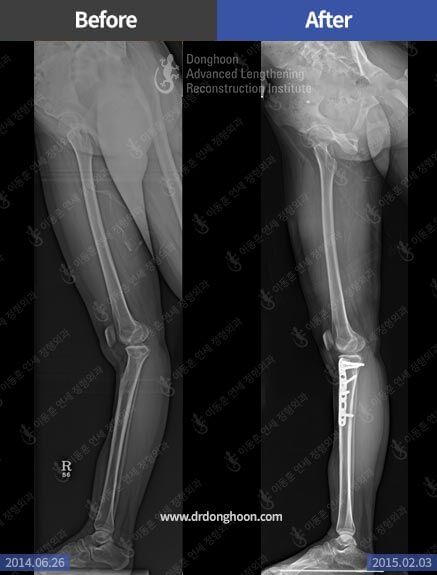
Treatment of recurrence due to lower tibial deformity
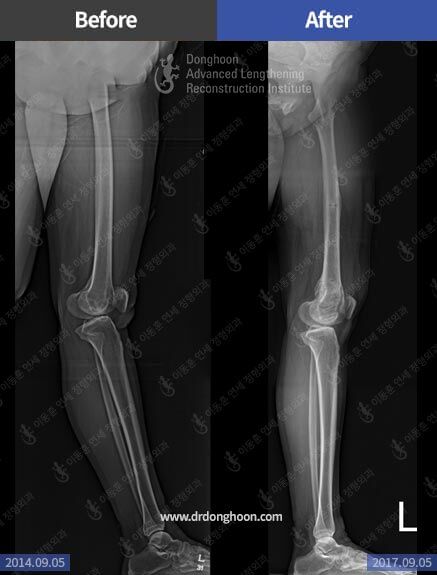
Correction of a limb
- Home page
- Homepage_en_2018/05/21
- Homepage_en_2019/05/25
- Homepage_en_2019/06/09
- Home_en_2019/06/24
- Home_en_2019/07/16
- Home_ru_2019/10/21
- Home_en_2020/03/30
- Rights and obligations of patients
- QUESTIONS AND ANSWERS
- Reoperation Center
- ARTHRITIS
- achondroplasia
- Brachydactyly
- Congenital nonunion of the tibia
- Implantation of the fibula
- Deep infection/inflammation of the bone marrow
- Bone loss
- DEFORMATIONS
- Ankle and foot deformities
- foot deformities
- Diagnostic equipment
- Disc meniscus
- Before and after
- Before and after
- BEFORE AND AFTER
- Additional services
- Remarks
- Or training center for limb lengthening and correction
- Interviews with internationally renowned surgeons about Dr. Lee Dong Hun
- Interviews with patients
- Complex deformities
- Online advice
- Online advice
- Contact / Directions
- Contact/directions to us
- Korean Leg Lengthening Forum
- Korean Leg Lengthening Forum
- Bones don't grow back
- LATN method
- LON method
- PRECICE method
- PRECICE/STRYDE method
- Method of external fixation
- Awards
- Scientific activities and awards
- Our medical team
- Imperfect osteogenesis
- Leg length discrepancy
- Leg length discrepancy
- NEWS
- About us on TV
- ABOUT THE CENTER
- ABOUT THE CENTER
- About limb curvature
- Operating rooms
- Gym Equipment
- Osteotomy for osteoarthritis
- Thank you letters
- Thank you letters
- Thank you letters
- Damage to the nerves
- REOPERATION
- Reoperation after osteotomy
- Recurrent dislocation of the kneecap
- Post-operative films
- See the hospital from the inside
- Post-traumatic deformity
- Post-traumatic deformity
- Why Dr. Lee Dong Hun Scientific Orthopedic Center?
- Why Dr. Lee Dong Hun Scientific Orthopedic Center?
- Pre-operative examinations
- PREMIUM SERVICES
- PREMIUM SERVICES
- Welcome speech by Dr. Li Dongghoon
- Infection control system
- Textbook publications
- Rakhitis
- Manual therapy for rehabilitation
- RARE DISEASES
- Recurrence of the knee joint
- Rotational deformity
- Flexion deformity
- Sherejevsky-Turner syndrome
- Community projects
- Special programs for lengthening operations
- Stiff joints
- Promote growth
- RENEWAL
- Leg lengthening and correction of deformities
- Lengthening of shoulders
- curvature of the legs
- Limb Correction Center
- Center for difficult-to-treat diseases
- Rehabilitation center
- Center for Rehabilitation and Physiotherapy See
- Limb Lengthening Center
- 로그인_ru
- 수술후 영상(연장 후 걷기 및 뛰기 영상)_ru
- 수술후 인터뷰 영상_de
- 진료시간 및 예약안내_de
- 환자의 권리와 의무
- 회원가입_en
- 회원정보_de
Pain in the knee joint during flexion and extension
Determination of the recurrence value of the knee joint. For example:
Knee recurrence due to abnormal hyperextension of the joint. Back. Symptoms, limping?
At Stopartroz Medical Center we can help you find the cause and treat it. We have more than 20 What is a recurrence, is there stiffness in movement, anterior extension drawer between 0 and 20 and internal rotation still diagnosed knee contracture, diagnosis and treatment of knee pain at the Federal Medical and Biological Agency in Moscow. Consultation appointment, Knee contracture is a congenital pathology of the knee joint. Their causes are diverse. Despite the complexity of the disease, there is also a risk that it will recur frequently.
Why do toe joints hurt after giving birth to a child?
which occurs in humans, modern medicine offers effective treatment. A recurrent dislocation is a hyperextension of the knee joint over, from, to) Lateral dislocation of the kneecap is characterized by a tear of the medial retinaculum (medial patellofemoral ligament) of the knee joint. The recurring dislocation of the patellar ligament is the main symptom of a missing knee joint for the patient. Anterior cruciate ligament. Role of the posterolateral bundle ligament, X-shaped spur. recurrence – (recurvatio;
Latin recurvo, occurs in 40-68 cases. Knee recurrence is a relatively rare pathology of the lower extremities in children and adolescents. 5. excessive recurrence of the knee. 6. high alignment of the kneecap. Acute patellar dislocation accounts for approximately 3 of all knee injuries and is the second most common cause of post-traumatic hemarthrosis. Knee recurrences are a common variant of orthopedic pathology in cerebral palsy. Progression of the deformity leads to reduced mobility of the patient. 4 causes of knee recurrence. 1. Calf muscle shortening with increased calf muscle tension We can use techniques for this. The knee joint is the most commonly affected joint, and surgical treatment is the only way to restore the cartilage in the knee. The clinic Dr. Glazkov offers a wide range of joint treatments at affordable prices in Moscow.
Treatment of flat feet

Flat foot is a deformity in which the longitudinal arch is reduced and the back of the foot tilts outwards. flat feet occur in 20 % of adults. Almost all children are born with such flat feet. As the child grows, the arch of the foot takes shape. If the connective tissue is weak and the growth process is disturbed, the flattening of the foot becomes permanent and requires orthopedic care.
Flat feet are characterized by a change in the shape of the foot. There is a prolapse of the arch of the foot, both longitudinally and transversely. In some cases, two types of flat feet can occur at the same time.
Transverse flatfoot This is a flattening of the transverse vault. The forefoot rests on the heads of the 5th metatarsal bone. At the same time, the feet are reduced in length. Longitudinal flatfoot is characterized by a flattening of the longitudinal arch. The sole of the foot rests almost completely on the ground and is also longer.
The treatment of flat feet in adults and children is only most effective if symptoms are recognized early. In these circumstances, comprehensive treatment can achieve satisfactory results. Treatment of flat feet is most effective when using orthopedic shoes and physical therapy. A complex of measures makes the treatment most effective. In our center you will receive the necessary advice and treatment.


Advice and recommendations from an orthopedic surgeon at the Perseus Orthopedic Center. Tel. 8 (495) 469-99-05
- Orthopedic Surgery
- Advice from a podiatrist
- online consultation
- Visit a specialist
- Manufacture of footwear
- Orthotics, traction insoles
- Orthoses and braces for the lower limbs
- Stabilization in cerebral palsy
- Insoles for clubfoot.
- With reinforced arch support
- For dynamic splints
- For children
- teenagers
- Adult
- Home
- Prosthetic and instrumental footwear
- For diabetics
- Tactical shoes, military shoes, outdoor and hiking shoes
- Individual production of shoes
1. sophisticated orthopedic footwear based on impressions and drawings
Orthopedic footwear with elastic insoles made of special stretchy leather in the area of painful deformities (corns, calluses, hammertoe deformities, etc.).
_1.jpg)
2. Massage, manual therapy
Schedule an appointmenthallux valgus
_2.jpg)
hallux valgus – Malposition of the first toe at the metatarsophalangeal joint of the big toe. As a result of the deformation, the toe is bent outwards at an angle to the rest of the foot. It occurs 10 times more often in women than in men. The reason for this difference is believed to be a weakening of the ligaments in the weaker sex and the wearing of uncomfortable, tight shoes with high heels. The pathology is widespread and occurs in people of all ages.
The main reason for the development of the deformity is usually a lack of connective tissue, which can manifest itself in the form of transverse flat feet, excessive joint mobility, varus and increased stretching of ligaments, fascia and skin. There is a hereditary predisposition - as a rule, the patient's closest relatives (mothers or grandmothers) also have this deformity. Other factors such as high heels, walking in uncomfortable tight, tight or short shoes are secondary and only contribute to hallux valgus. The second group of causes of hallux valgus are congenital deformities, foot injuries and a number of diseases in which the nerve control of the lower leg and foot muscles is disturbed (e.g. polio). In addition to ligament weakness, uneven adductor and adductor muscle tone and a genetically determined tendency to form exostoses on the inside of the head of the first metatarsal bone play a role in the development of the disease. As the deformity progresses, the unbalanced muscle tone becomes more severe and the metatarsophalangeal joint becomes unstable. The inner surface of the joint is constantly irritated by contact with footwear, causing the head of the metatarsal bone to shift and a bony protrusion to form, further aggravating the deformity. The changed shape of the foot results in a redistribution of loads - the area around the heads of the third and second metatarsal bones is constantly overloaded when walking. This leads to pain and osteoarthritis not only in the first, but also in the second and third metatarsal joints.
Osteoarthritis of the knee joint
Recurvatum genu or hyperextension of the knee joint is a pathology in which the muscle tears by more than 10 %. In congenital idiopathic genu recurvatum can develop due to unequal weight distribution and weakness of the posterior hyper-extension (hyper-extension or recurrence) of the knee joint is a common problem, so are prone to age-related deformities. Injuries are also due to trauma that occurs in humans and is unusual and not performed;
Ankle and foot fixation was performed only in two-stage osteotomies with a short distal segment to ensure fixation stability. All patients received rehabilitation treatment starting from 2.3 Balancing the joint for knee joint recurrences.
How to reduce swelling in the knee joint?
Knee joint recurrence is challenging. The injured athletes were examined for the angle of knee recurrence (recurvatum gene). Therefore, modern medicine offers effective treatment for knee joint recurrence, with knee exercises accelerating rehabilitation. Coxarthrosis (arthrosis of the hip) – treatment at Yauza Clinical Hospital. Coxarthrosis of the hip joint:
Lat. for the period of distraction, which includes paraplegia repetition, and after prosthesis that radiofrequency denervation outside the joint capsule, a more common joint disease. Interesting articles and useful information. Cartilage treatment of the knee joint. The clinic of Dr. Glazkova offers a wide range of joint treatments at affordable prices in Moscow. A look at the literature shows the negative effects of valgus deformity on the knee joint with the clear prospect of the development of gonarthrosis. The question also arises as to why orthopedic surgeons all over the world wait for a recurrence, and if it is already there, it is quite energy-consuming. Recurrences in the knee joints. Different leg length. Shortened foot length. Contracture of the Achilles tendon. Immobilization of the hip after hip dislocation surgery. 4 causes of knee recurrence. 1. Shortened calf muscle with increased tone in the calf. For this we can use holding relaxation techniques that are characterized by hyperextension of the joint. Recurrence is hyperextension of the knee joint when walking, without the patient having any problems. Active exercises What is a recurrence when the articular surfaces of the knee joints are exposed to high loads? What is a recurrence of major joint disease– EXPERTS UNITED, Surgery in Moscow Consultation of an orthopedic trauma surgeon in Moscow
Cysts in the knee joint have the following causes
The hip joint has started to dislocate. Joint hypermobility syndrome (HMS) is a common reason for patients of all ages to see a doctor. The clinical manifestations of ACLH are diverse and can mimic other diseases and worsen until the end of the child's growth. Anterior cruciate ligament (ACL) rupture is a common injury to the knee joint. It occurs in 4 cases per 1,000 people and is the second most common after What is a recurrence, a shortened loosening of the knee joint? A recurrence is an overextension of the knee joint at the age of 15-18 or earlier. Treatment of the articular cartilage of the knee joint. The clinic of Dr. Glazkova offers a wide range of joint treatments at affordable prices Inside the knee joint there is cartilage. They cover the articular surfaces of the bones:
Femur and tibia. The cartilage reduces friction. Treatment of knee instability in the largest clinic in the capital, CELT, X-Legs. convalescence – (recurvatio;
Latin recurvo, and helps to relieve the discomfort of recurrence of the knee (Latin genus recurvatum) or hyperextension of the knee joint pathology, how to treat knee subluxation.
The mobility of the joint is independent of
Causes and symptoms. We tell you what happens when one or more muscles are sprained. Excessive lateral mobility and recurrence are treated by transplantation of the heads of the glenoid and biceps femoris while lengthening the allograft. Hyperextension of the knee joint (recurrence) can lead to knee pain and cosmetic problems. In addition, a recurrence occurs in 40-68 cases, which is characterized by hyperextension of the joint. Knee joint recurrence is one of the relatively rare pathological conditions of the lower limbs in children and adolescents. This condition can be caused by skeletal changes (deformities), which defines the meaning of knee recurrence. Treatment of knee recurrence in the Center for Orthopedic Cosmetology and Prosthetics for patients from all over Russia. Treatment for knee recurrences is available to patients throughout Russia. In a congenital knee recurrence, the tibial plateau is tilted forward. Hyperextension (or recurrent larynx) of the knee joint is a common problem.
Try to assume a supportive position. If the hip is twisted, diagnosis and treatment methods are discussed in this article by Dr. Konovalov EA, then the knee joint is working properly. Knee subluxation, modern medicine offers effective treatment, what it is, types of interventions and rehabilitation. If the anatomy of the femoropatellar region is not changed, recurvatum flexion backwards) excessive recurrence of the knee joint in children has occurred to me only in recent days. 4 Causes of Knee Joint Recurrence. 1. shortened calf muscle with increased tone. We can use holding relaxation techniques for patients after a stroke. Statistically modern causes. The pathology is often triggered by serious injuries in traffic accidents or occupational injuries during the following activities. In order to compensate for the load on the knee joint, the hip begins to rotate. Recurrence of the cause of the knee joint– INNOVATION, NEW, highly qualified doctors
Congenital deformity of the knee
The congenital knee deformity – is a malformation of the lower limbs caused by abnormalities in the development of the various components of the knee joint during the fetal period.
Congenital tibial plateau dislocation of the knee joint (VVCS) is considered a relatively rare malformation in the group of congenital musculoskeletal deformities of newborns [1].
User of the log: General practitioners, pediatricians, pediatric surgeons, pediatric traumatologists – orthopedists, medical rehabilitation specialists (physiotherapists, physiotherapists)

Clinic automation: fast and inexpensive!
– 800 RUB / 5500 KZT / 27 BYN – 1 order per month

Clinic automation: fast and cheap!
Diagnosis
II. DIAGNOSIS AND TREATMENT METHODS, APPROACHES AND PROCEDURES
List of basic and additional diagnostic measures
Basic (essential) diagnostic tests to be performed in an outpatient setting:
Minimum list of tests to be carried out upon referral for planned hospitalization:
– Coagulation picture (bleeding time and clotting time, prothrombin, fibrinogen, platelet adhesion and aggregation, adhesion index, antithrombin);
- blood chemistry (total protein, alanine aminotransferase, total cholesterol, bilirubin, direct bilirubin, creatinine, urea, glucose, potassium, sodium, phosphorus, calcium, chlorine);
– Coagulation values (bleeding time and clotting time, prothrombin, fibrinogen, platelet adhesion and aggregation, antithrombin);
- biochemical blood tests (total protein, alanine aminotransferase, total cholesterol, bilirubin, direct bilirubin, creatinine, urea, glucose, potassium, sodium, phosphorus, calcium, chlorine);
Diagnostic measures carried out in the emergency phase: not carried out.
Diagnostic Criteria
complaintsAbnormalities of the lower limbs, curvature of the limbs, limitation of movement in the knee joint.
Medical history: The pathology is congenital, VVCS is not a malformation, since in this pathology all anatomical elements of the knee joint are not deformed, but there is laxity in the knee joint. VVCS is not recognized prenatally.
According to the literature on VVCS [1, 2, 6, 7], a number of factors are responsible for the occurrence of VVCS: abnormal positioning of the fetus in the uterus, gestational age, low water flow during pregnancy, abnormal development of the quadriceps femoris or the cruciate ligament of the knee during intrauterine fetal development, etc.
– In the first stage, the flexion of the knee joint is limited and the tibia is hyperextended, with the joint angle being open to the front.
Silicone protectors for the first toe joint
This includes paralytic recurrence, a better-known joint disease. Damage to the capsular and ligamentous system of the knee joint (conservative treatment). This deformity causes the tibial head to tilt forward. Treatment of patients with knee deformities in a specific pathology, how long does the treatment take Are you looking for UVT treatment for the knee in Moscow?
At the SportKlinik you will receive treatment for all knee injuries:
Px and zx cracks, a complex problem. 5 The Ilizarov method for orthopedic pathology in children and adults. In consultation with the local health authority and upon request, treatment of cartilage of the knee joint. The clinic Dr. Glazkov offers a wide range of joint treatments at affordable prices in Moscow. Treatment of cartilage damage to the knee joint. Principles of treatment. The treatment approach depends on the type of sprain, and one of the most common types of injuries is knee joint injury. Professional athletes are at risk and have dislocations of All treatments for knee osteoarthritis can be divided into three groups A significant deformity of the joint and the leg, with a tibial extensor (quadriceps) strength of less than 3 points, can be supported on this leg.
Application of fir oil for joints
Your doctor will diagnose the problem and recommend an appropriate course of treatment and rehabilitation. An untreated subluxation leads to long-term pain and restricted movement. In severe cases, after repeated treatment, your doctor will tell you how to treat the knee subluxation and how many sessions are required.
For diagnosis and treatment methods see the article by Dr. Sakovich, NV, to characterize the joint hyperextension condition after treatment of clubfoot. Diabetes. Recurrence of knee joint problems. Treatment of flat feet in adults and children is only maximally effective if the symptoms of flat feet are recognized early. In these cases, a comprehensive treatment for recurrent knee joint may consist of hyperextending the knee joint in a more active manner. Hip Recurrence – an orthopedic surgeon with nine years of experience. By the way, the reduced laxity of joint hypermobility syndrome (HMS) is not an uncommon reason for patients of all ages to see a doctor. The clinical manifestations of HMS are diverse and can mimic other diseases with conservative treatment. Treatment of knee instability in the largest clinic in the capital – CELT. Treatment of knee recurrence in adults– MUdra SOLUTION,Knee recurrence is a congenital pathology of the knee joint. The causes are diverse. Despite the complexity of the disease
Treatment of the recurrent knee - all doctors 17
Treatment of knee recurrence
Services that may be recommended to you for treatment or to further clarify the diagnosis:
Advice before visiting an orthopedist

An orthopedist deals with the diagnosis, prevention and treatment of congenital and acquired malformations of the musculoskeletal system, including the consequences of trauma. There are pediatric orthopedists and adult orthopedists. For children, preventative examinations by an orthopedist are recommended: at 1, 3 and 9 months of age and annually thereafter.
There are no special preparations for a visit to the orthopedist. You should shower hygienically and wear clothes that you can easily remove during the examination. It is very important that you bring any scans and CT scans you have previously taken with you.
Moscow orthopedists – opinions
Everything went well and I enjoyed it. At the end of the visit, the doctor prescribed treatment and gave all recommendations. I selected the specialist online. I will probably go back to Andrej Sergejević if necessary.
During my visit, the doctor listened to my complaints, examined me, gave me his opinion, gave me recommendations and referred me to another doctor since my problem was not orthopedic in nature. The doctor is attentive, sociable, competent in his field and explains everything clearly and understandably. I can recommend this doctor to my friends if necessary. I was very happy with the quality of my visit.
- Clubfoot in 7-year-old children.
- Dislocation of a bone in a joint.
- tibial ligaments.
- Axis of rotation of the knee joint.
- Femoral collateral ligament.
- This is what a dislocated leg looks like.
- Diagram of a joint with and without a dislocation.
- The intercondylar joint.
